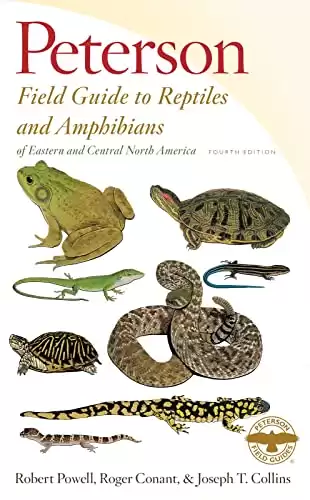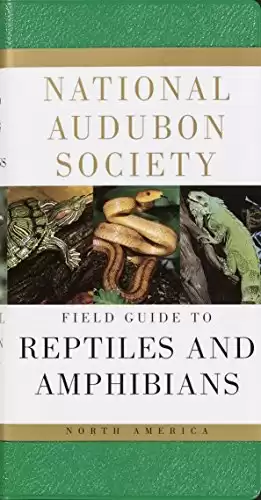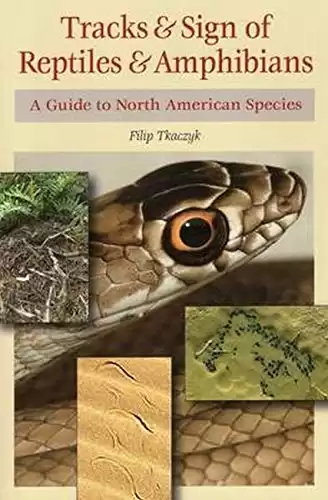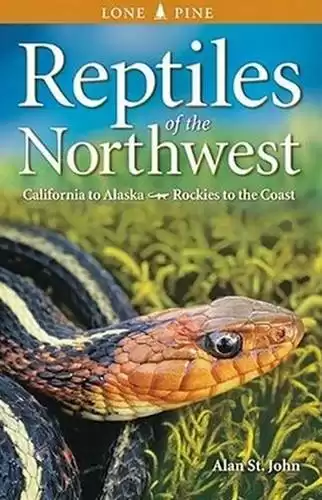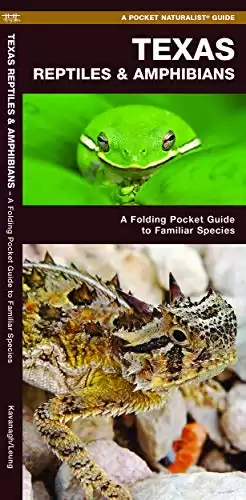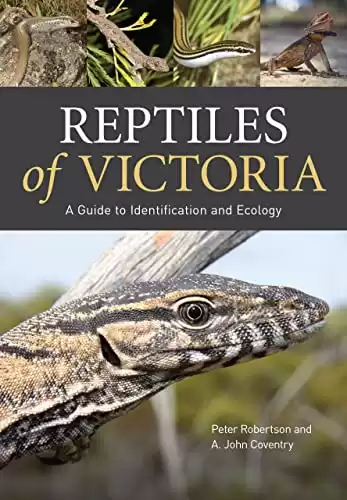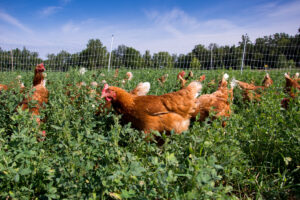The literal meaning of reptiles is “those that creep.” It’s funny how that worked out, because not only do they creep from place to place, but they also creep some people out!
You should know that reptiles don’t only include lizards and snakes. There are many other reptiles around us, including crocodiles, alligators, turtles, tortoises, and everyone’s favorites, dinosaurs. (This review doesn’t include books about dinosaurs. If you wish to learn more about these extinct reptiles, you can check out our blog section, or this article about dinosaur books.)
Most of the books in this review include amphibians as well as reptiles, so you’ll be able to identify any of those you happen across in the field.
A-Z-Animals’ Top Picks for the Best Books About Reptiles
1. Peterson Field Guide To Reptiles And Amphibians Eastern & Central North America by Robert Powell (Author), Roger Conant (Author), and Joseph T. Collins (Author)
Peterson Field Guide To Reptiles And Amphibians Eastern & Central North America is a comprehensive guide entailing all that you need to know about reptiles and amphibians. This edition of the bestselling field guide covers descriptions of more than 595 species, including 122 newly recognized species. You’ll learn how to identify different species and all about their habitat, ranges, subspecies, conservation status, and an interesting tidbit, their voice descriptions!
It was written by three authors, Robert Powell, Roger Conant, and Joseph T. Collins. Robert and Joseph are big names in the scientific world and have written numerous articles and books. Robert is a biologist, while Roger and Joseph are herpetologists. The book is from a series of field guides on various classes of animals.
The guide features more than 100 color photographs and 322 color distribution maps that illustrate where species reside. Graphics include track prints of the reptiles. This 512-page field guide is only available in paperback.
Several fans of the previous (third) edition said that this edition contains 122 fewer pages. Some readers also reported a few errors.
Pros and Cons of Peterson Field Guide To Reptiles And Amphibians Eastern & Central North America by Robert Powell (Author), Roger Conant (Author), and Joseph T. Collins (Author)
| Pros | Cons |
|---|---|
| This comprehensive field guide includes amphibians as well as reptiles. | It’s only available in paperback. |
| It contains over 595 species, including 122 newly recognized species that weren’t included in the previous edition. | Several fans of the previous (third) edition said that this edition contains 122 fewer pages. |
| You’ll learn how to identify different species and all about their habitat, ranges, subspecies, conservation status, and their voice descriptions! | Some readers also reported a few errors. |
| This book is from a series of field guides on various classes of animals. | |
| The guide features more than 100 color photographs and 322 color distribution maps that illustrate where species reside. Graphics include track prints of the reptiles. |
- 512 pages.
- A comprehensive guide for readers of all ages.
- It covers 595 species and is the best-seller field guide.
2. National Audubon Society Field Guide to Reptiles and Amphibians: North America by John L. Behler and F. Wayne King
National Audubon Society Field Guide to Reptiles and Amphibians: North America by John L. Behler and F. Wayne King is considered to be one of the most comprehensive field guides to North American reptiles and amphibians. It’s important to note that it doesn’t include recently discovered species. But it is top-ranked, vinyl-coated, portable, and reliable enough to be used in the field.
It is written by two authors, John L. Behler and F. Wayne King. Behler, who died in 2006, wrote many books about conservation and was an expert in herpetology (the study of amphibians and reptiles). King has also written many books, most of which were about reptiles.
This field guide includes 700 incredible photographs which may appear dated since the book was published in 1979. But these detailed and attractive photos still serve as critical identifiers for reptiles in North America. It is a heavy book with 744 pages but is not a tedious read. It’s available in vinyl-bound and paperback versions.
A couple of readers noted that the photos and descriptions are in different sections.
Pros and Cons of National Audubon Society Field Guide to Reptiles and Amphibians: North America
| Pros | Cons |
|---|---|
| This is considered to be one of the most comprehensive field guides to North American reptiles and amphibians. | It was published in 1979, so it doesn’t include more recently discovered species and the photos are somewhat dated. |
| The vinyl-coated version is ideal for field use. | A couple of readers noted that the photos and descriptions are in different sections. |
| The authors, John L. Behler and F. Wayne King, were experts in herpetology and authored many books about amphibians and reptiles. | |
| The book includes 700 photographs to help you identify reptiles and amphibians. |
- 744 pages.
- Vinyl-coated and can be carried outdoors.
- A collector's item.
3. Tracks & Sign of Reptiles & Amphibians: A Guide to North American Species by Filip A. Tkaczyk
Tracks & Sign of Reptiles & Amphibians: A Guide to North American Species by Filip A. Tkaczyk is a fantastic guide to learning about reptiles and amphibians. It includes more than 600 color photographs of various species which you can spot and identify. Moreover, it also includes detailed information on the nests and eggs of these creatures.
This book was written by Filip A. Tkaczyk, an outdoor educator and wildlife tracker who has a BS in Wildlife Science from the University of Washington and holds the rank of Specialist in Track & Sign from CyberTracker.
In addition to the above-mentioned photos, you’ll find range maps and line drawings that illustrate the tracks and signs of reptiles and amphibians. You can find tracks and signs left by the reptiles and match them with the ones in the book to see which species are creeping near you.
This guide includes 480 pages and is available in paperback.
A sole reviewer noted that this book didn’t include many species from Canada, which, is part of North America.
Pros and Cons of Tracks & Sign of Reptiles & Amphibians: A Guide to North American Species by Filip A. Tkaczyk
| Pros | Cons |
|---|---|
| This guide includes over 600 color photos of North American reptile and amphibian species. | It’s only available in paperback. |
| It also includes detailed info on the nest and eggs of these animals. | A sole reviewer noted that this book didn’t include many species from Canada, which is part of North America. |
| This book was written by Filip A. Tkaczyk, an outdoor educator and wildlife tracker who has a BS in Wildlife Science from the University of Washington and holds the rank of Specialist in Track & Sign from CyberTracker. | |
| This field guide includes range maps and line drawings that depict the tracks and signs of reptiles and amphibians. |
- 480 pages.
- Carries photographs of tracks and signs of species.
- Learn about nests and eggs as well.
4. Reptiles of the Northwest: Alaska to California, Rockies to the Coast by Alan St. John
Reptiles of the Northwest: Alaska to California, Rockies to the Coast is one of the best field guides for beginners. It is easy to use and read. It is an updated book with more than 42 reptiles, ranging from most lizards to various turtles and snakes. They are all color-coded, which makes identification easier. You’ll also learn about their habitat, distribution, and behavior through the field notes written by the author. You can also find a ruler attached to your purchase to help you measure reptiles. But this is not something we recommend unless you are an expert.
It is written by Alan St. John, who used to be a reptile keeper at Portland’s zoological park and has conducted reptile and amphibian field surveys for the Oregon Department of Fish and Wildlife and for the U.S. Forest Service and Bureau of Land Management. As an interpretive naturalist, St. John teaches about the natural world through writing, photography, pen-and-ink drawings, and color paintings.
The whole book is filled with photographs that will allow you to quickly identify reptiles in the field. You can also find pictures of less common reptiles, which is a huge plus. It’s 272 pages and only available in paperback format.
Because it’s specific to the Northwest, it won’t be useful as a field guide unless you live in that area or are visiting.
Pros and Cons of Reptiles of the Northwest: Alaska to California, Rockies to the Coast by Alan St. John
| Pros | Cons |
|---|---|
| This easy-to-use field guide includes over 42 reptiles that live in the Northwest. | It’s specific to the Northwest, so unless you live in that area or are visiting, it won’t be useful as a field guide. |
| The entries are color-coded for easy identification. | This field guide is 272 pages and only available in paperback format. |
| You’ll also learn about their habitat, distribution, and behavior. | |
| The book includes a ruler to help you measure reptiles, which is not something we suggest. | |
| The author, Alan St. John, is a former reptile keeper at the Portland zoo and has conducted reptile and amphibian field surveys for state and federal departments. | |
| St. John is an interpretive naturalist who teaches about the natural world through writing, photography, pen-and-ink drawings, and color paintings. | |
| The book is filled with photos to help you identify reptiles in the field, including less-common species. |
- 272 pages.
- Easy to read with color-coded species.
- Contains field notes by the author.
5. Texas Reptiles & Amphibians: A Folding Pocket Guide to Familiar Species by James Kavanagh (Author), Raymond Leung (Illustrator)
Texas Reptiles & Amphibians: A Folding Pocket Guide to Familiar Species is a folding guide that’s one of the best identification resources for reptiles. It’s portable and can be taken on trips to reptile viewing spots. There is also a map at the end of this guide discussing viewing spots and showcasing all the state’s hot places you can visit. But do note that it only contains reptiles and amphibians found in Texas.
This guide was written by James Kavanagh and illustrated by Raymond Leung. James is a zoologist who has written over 500 manuals, introducing both plants and animals to the common folk.
There are only 12 pages in this guide, which features foldable pages on both the front and back. But the whole guide has necessary identifiers and beautiful graphics that make identifying reptiles and amphibians easy.
Pros and Cons of Texas Reptiles & Amphibians: A Folding Pocket Guide to Familiar Species by James Kavanagh (Author), Raymond Leung (Illustrator)
| Pros | Cons |
|---|---|
| This portable guide includes a map featuring viewing spots and hotspots where you’re likely to find Texas reptiles and amphibians. | It only contains reptiles and amphibians found in Texas. |
| It was written by James Kavanagh, a zoologist, and illustrated by Raymond Leung. | It’s only 12 pages long. |
| While it’s only 12 pages long, it includes the necessary identifiers and beautiful graphics that makes identifying regional reptiles and amphibians easy. |
- 12 pages.
- Portable and easy to use outdoors.
- Carries a map with the best viewing spots.
- A quick read.
6. Reptiles of Victoria: A Guide to Identification and Ecology by Peter Robertson and A. John Coventry
If you live in Victoria, Australia, you’ll want to add Reptiles of Victoria: A Guide to Identification and Ecology to your library. It covers all 123 species of reptiles, including native, introduced, and vagrant species. In addition to identifying them, this guide tells you their habitat, biology, ecology, and distribution.
The book also indicates the level of risk that venomous snakes pose to humans. It even includes a brief section on first aid for snake bites!
The book was written by Peter Robertson and A. John Coventry. Robertson undertook regional fauna surveys and coordinated the research and management of several threatened reptiles and amphibian species before founding an ecological consultancy where he investigates the conservation management of the state’s fauna. He also took many of the photos in this text.
Coventry was Senior Curator of Herpetology at the National Museum of Victoria (now Museums Victoria) for almost 50 years. In recognition of his contributions to herpetology, two species of skinks are named after him.
This book, which is available in Kindle and paperback formats, is 336 pages long and it’s text-heavy, with few photos. Having said that, the photographs that are included almost look like they are in HD and are quite pleasing to the eye.
Pros and Cons of Reptiles of Victoria: A Guide to Identification and Ecology by Peter Robertson and A. John Coventry
| Pros | Cons |
|---|---|
| This book includes all 123 species of reptiles that live in Victoria, Australia, including native, introduced, and vagrant species. | It is specific to Victoria, Australia, so unless you live there or plan to visit, it won’t be very useful as a field guide. |
| In addition to identifiers, you’ll learn each specie’s habitat, biology, ecology, and distribution. | This book includes 336 pages and is text-heavy with few photos. |
| It also indicates the risk that each venomous species poses to humans and includes a brief section on first aid for snake bites. | |
| It was written by Peter Robertson and A. John Coventry, two expert herpetologists. | |
| The photos that are included are stunning. |
- 336 pages.
- Explores all the reptiles in Victoria, Australia.
- Contains stunning pictures.
- A long read.
How to Choose the Best Book About Reptiles
When you’re selecting a book about reptiles, there are three main criteria that you should consider: location, focus, and portability. Let’s look at those factors in detail.
Location
The first three titles in our review contain information about reptiles that are native to North America. These books will be useful to anyone who wants to learn how to identify reptiles or amphibians regardless of where they live in North America. Our third and fourth selections were written to identify these creatures in the Northwest and in Texas respectively, so they won’t be useful as field guides outside of those places. And the final book in the review covers reptiles that live in Victoria, Australia.
Focus
Five of the books in this review focus on identifying reptiles by their appearance. Tracks & Sign of Reptiles & Amphibians: A Guide to North American Species by Filip A. Tkaczyk, on the other hand, will help you identify these animals by examining tracks, nests, eggs, and other signs.
Portability
If you’re looking for a portable field guide, consider the number of pages and the format. You may not want to lug around a 500-page paperback, but the same book will be easy to carry in your backpack in Kindle version. Also, some field guides are available with vinyl covers, which makes them more practical than plain paperbacks.
Thank you for reading! Have some feedback for us? Contact the AZ Animals editorial team.

